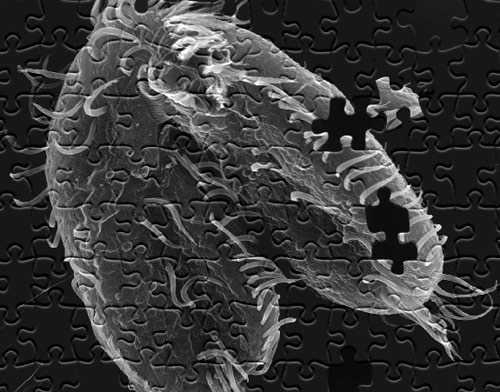Chromosomes that break apart and reassemble in a different order usually signal trouble. In humans, for example, a reshuffling of chromosomal contents amounts to genomic chaos, a harbinger of cancer. But in Oxytricha trifallax, a peculiar single-celled organism, a ragtag genome seems to be advantageous.
Oxytricha trifallax has the remarkable ability to break its own DNA into nearly a quarter-million pieces and rapidly reassemble those pieces when it’s time to mate. The organism internally stores its genome as thousands of scrambled, encrypted gene pieces. Upon mating with another of its kind, the organism rummages through these jumbled genes and DNA segments to piece together more than 225,000 tiny strands of DNA. This all happens in about 60 hours.
Chaotically organized genomes are hardly unknown, but Oxytricha trifallax is an extreme case. Accordingly, it has attracted the attention of researchers. For example, a team of researchers at Princeton recently published a report on the organism’s unusually elaborate genomic rearrangements.
The researchers, led by Laura Landweber, Ph.D., a professor of ecology and evolution biology, summarized their work August 28 in the journal Cell, in an article entitled, “The Architecture of a Scrambled Genome Reveals Massive Levels of Genomic Rearrangement during Development.”
Oxytricha stands apart from other microorganisms in several respects, Dr. Landweber said. It is a large cell, about 10 times the size of a typical human cell. The organism also contains two nuclei whereas most single-celled organisms contain just one.
An individual Oxytricha cell keeps its active DNA in one working nucleus—the somatic nucleus—and uses the second to store an archive of the genetic material it will pass along to the next generation. The genome of this second nucleus—the germline nucleus—undergoes the dismantling and reconstruction to produce a new working nucleus in the offspring.
In the Cell article, the researchers reported on the Oxytricha germline genome and compared it to the somatic genome to present a global view of its massive scale of genome rearrangements.
“The remarkably encrypted genome architecture contains >3,500 scrambled genes, as well as >800 predicted germline-limited genes expressed, and some posttranslationally modified, during genome rearrangements,” wrote the authors. “Gene segments for different somatic loci often interweave with each other.”
The authors also noted that hundreds of germline-limited genes are expressed during development, then deleted.
Oxytricha uses sex solely to exchange DNA rather than to reproduce—like plant cuttings, new Oxytricha populations spawn from a single organism. During sex, two organisms fuse together to share half of their genetic information. The object is for each cell to replace aging genes with new genes and DNA parts from its partner. Together, both cells construct new working nuclei with a fresh set of chromosomes. This rejuvenates them and diversifies their genetic material, which is good for the organism, Dr. Landweber observed.
In the Cell article, the authors noted that their work had uncovered a powerful model for studies of genome rearrangement. This model could, for example, provide a template for understanding how chromosomes in more complex animals such as humans break apart and reassemble.
While chromosome dynamics in cancer cells can be unpredictable and chaotic, Oxytricha presents an orderly step-by-step model of chromosome reconstruction. “The process in Oxytricha recruits some of the same biological mechanisms that normally protect chromosomes from falling apart and uses them to do something creative and constructive instead,” noted Dr. Landweber.



